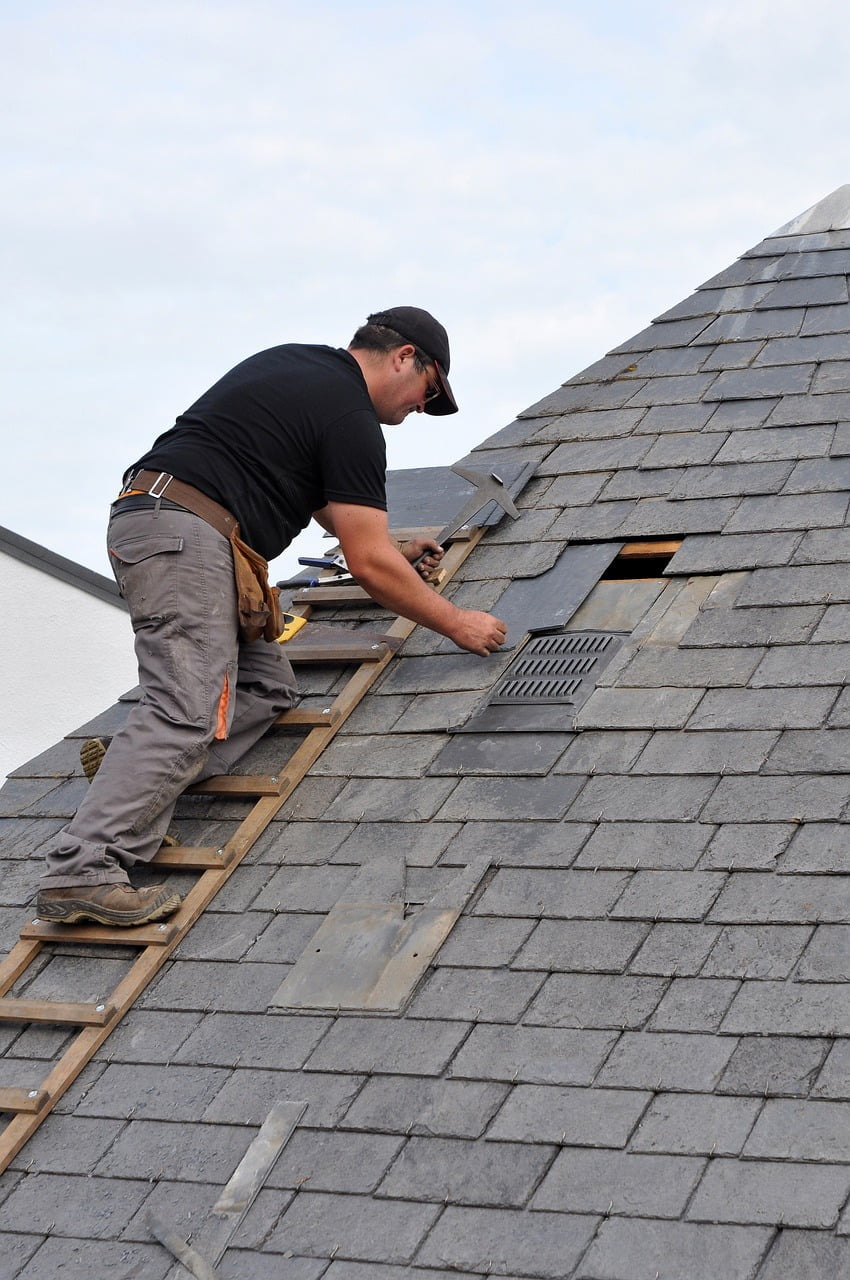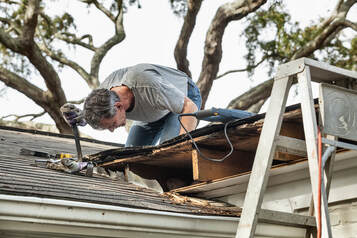Seasonal Roofing System Repair Service List: Prepare Your Roof for Every Weather
As a home owner, you recognize the importance of securing your investment, and your roof plays a crucial duty in that. Each season brings unique obstacles that can impact its honesty. By adhering to a seasonal roof covering fixing checklist, you can stay in advance of possible issues. From winter months ice dams to summer season warm, each action is considerable. Let's check out how proper upkeep can safeguard your home and prolong your roofing's life expectancy.
Examining Your Roof Covering for Wintertime Readiness
As winter season techniques, it's important to inspect your roofing to confirm it can hold up against rough weather. Beginning by checking for missing or harmed tiles; also a small problem can cause significant leakages when snow and ice gather. Next off, check out the flashing around vents and smokeshafts-- this location is typically vulnerable to water breach.
Don't neglect to look for indications of drooping or irregular surface areas, as these might indicate structural problems. Additionally, validate your gutters are clear; clogged up seamless gutters can lead to ice dams that harm your roof.
 roof repair
roof repair
Springtime Cleansing: Cleaning Debris and Monitoring for Damages
When winter months's grasp releases, it's time to tackle springtime cleaning on your roof by removing particles and inspecting for any kind of damage. Start by examining your roofing system for fallen branches, leaves, and various other debris that can catch moisture and cause rot. A tidy roofing promotes better drain and prevents mold and mildew development.
Following, grab a durable ladder and very carefully examine tiles for cracks or missing out on items. Take notice of locations around vents and smokeshafts, as these areas are vulnerable to leakages. Don't forget to analyze your gutters, ensuring they're devoid of blockages that could lead to water merging.
While you're up there, seek signs of wear, like corrosion on metal blinking or loose seals around skylights. If you find any kind of problems, addressing them now can save you from pricey fixings later. A little spring cleansing goes a long method in keeping your roofing system's integrity.
Summer Season Heat: Examining Your Roof Covering for Heat-Related Issues
As summer season warm increases, it's vital to inspect your roof covering for heat-related problems. Look for any kind of tile damage, look for indications of warm fastening, and assess how well your roof aerates. Taking these actions now can protect against larger problems down the roadway.
Examine for Roof Shingles Damages
 roof repair
roof repair
Inspect for Warmth Buckling
Warm fastening is a common concern that can emerge during the scorching summertime months, and it's important to look for it on your roof. As temperature levels soar, roofing materials, especially asphalt tiles, can increase and agreement. This movement can bring about bending, creating unattractive bulges or cracks. Start by evaluating your roofing aesthetically; search for any type of irregular surfaces or raised sides. Pay special interest to areas around vents and smokeshafts, where buckling is most likely to take place. It's vital to address them without delay to stop additional damages if you spot any kind of signs of warmth fastening. If you're not sure regarding the degree of the problem or how to fix it efficiently., consider seeking advice from a specialist.
Evaluate Roof Air Flow Effectiveness
After examining for heat buckling, it's vital to evaluate your roofing's air flow performance. Proper ventilation assists manage temperature and wetness, stopping damages from too much heat. Keep in mind, keeping great ventilation not just lengthens your roofing's life however additionally boosts your home's overall power performance, guaranteeing convenience throughout those hot summer months.
Rainy Season Preparedness: Ensuring Appropriate Drain
As the wet season approaches, you need to guarantee your roof's drain system is all set to handle heavy downpours. Start by evaluating your rain gutters and downspouts, and make certain they're free from debris. Don't forget to examine the blinking and seals to stop leaks and water damage.
Evaluate Rain Gutters and Downspouts
During the stormy season, it is important to regularly examine your gutters and downspouts to ensure correct water drainage. Beginning by examining for any visible debris, like twigs or fallen leaves, that might obstruct the flow of water. Make certain the seamless gutters are securely connected and free from drooping, as this can catch water and result in leaks. Next, take a look at the downspouts for blockages or damage; an obstructed downspout can create water to overflow, potentially harmful your roof covering and structure. Also, verify that downspouts straight water away from your home's foundation. Resolve them promptly to stop expensive repair work if you identify any kind of problems. When heavy rains hit., a little upkeep currently can save you big migraines later.
Clean Roofing Surface Debris
To assure your roof can handle the stormy period, it's necessary to clean up any debris from the surface on a regular basis. https://jimplacknews.com/ll-roofing-delivering-excellence-in-roofing-solutions-for-gainesville-and-beyond/ Leaves, branches, and dirt can collect, blocking drain paths and triggering water to pool. This trapped water can bring about leakages and damages over time. Order a sturdy ladder and check your roofing for any type of build-up. Make use of a roof covering rake or mop to gently remove particles, being careful not to harm the shingles. Don't fail to remember to examine your rain gutters as well, guaranteeing they're clear and functioning appropriately. After cleaning, check your roofing after hefty rains to detect any kind of potential issues early. Maintaining your roofing system free from debris is vital for avoiding expensive repair work down the line.
Examine Flashing and Seals
After clearing your roofing of debris, take a better look at the blinking and seals around vents, skylights, and smokeshafts. If you observe any type of damages, it's important to repair or change it quickly. Ensuring these components are in great condition will certainly help keep appropriate drainage and shield your home from water damages throughout heavy rains.
Checking and Maintaining Roof Seals and Flashing
While it may appear simple to forget, inspecting and maintaining roof seals and flashing is important for stopping leakages and water damages. Start by inspecting the seals around vents, skylights, and chimneys. Look for any kind of splits, gaps, or indications of wear. If you find any type of problems, it's best to reseal them with proper roof sealer to ensure a tight fit.
Following, take a look at the flashing, which directs water far from crucial areas. Look for rust, loose sections, or bent edges. Replace it or secure it properly to maintain its honesty if you discover any kind of broken flashing. Bear in mind, also a little flaw can cause considerable issues later on.
Last but not least, don't fail to remember to clean off any type of particles that may obstruct the seals or flashing. Maintaining these parts healthy will help safeguard your roofing versus the aspects and expand its life expectancy.
Gutter Maintenance: Keeping Water Flowing Smoothly
Considering that your rain gutters play an essential function in directing rainwater away from your home, normal upkeep is critical for avoiding water damage and foundation issues. Beginning by clearing out particles like fallen leaves, twigs, and dust. A clogged up seamless gutter can lead to water overflow, which may harm your roof and house siding. Use a sturdy ladder to reach the rain gutters securely, and wear gloves to shield your hands.
Next, inspect for any type of signs of rust, holes, or drooping sections. If you observe any type of damage, repair or change the damaged components immediately. Verify downspouts are guiding water at the very least 6 feet far from your foundation. If essential., think about including extensions.
Lastly, examine that your rain gutters are correctly sloped, ideally a quarter inch for each 10 feet. This slope assurances water streams smoothly toward the downspouts. Routine upkeep will certainly maintain your seamless gutters operating effectively and safeguard your home from expensive repairs.
Setting Up Specialist Inspections for Comprehensive Treatment
Frequently organizing expert evaluations is vital for preserving your roofing's stability. These specialists can spot potential issues prior to they become costly repairs. Objective for a minimum of two inspections a year-- one in the springtime and one more in the fall. This timing allows you to attend to any kind of damage created by winter season weather condition or summer tornados.
During inspections, professionals will certainly assess tiles, flashing, and air flow, making certain everything's in leading form. They'll likewise check for indications of wear, leakages, or mold and mildew, which you could overlook. Scheduling these examinations not just prolongs your roofing system's life expectancy but likewise gives you satisfaction.
If you're not sure concerning the problem of your roof covering, don't wait to call an expert. Spending in these examinations currently can conserve you a great deal later. Prioritize your roofing system's wellness, and you'll be well-prepared for whatever climate comes your method.
Often Asked Questions
How Usually Should I Check My Roofing System Throughout the Year?
You need to examine your roofing system at least twice a year, preferably in springtime and autumn. After severe weather events, look for damage as well. Regular inspections help you capture issues early and save cash on repair work.
What Indicators Indicate I Required a Roofing System Replacement Instead of Repair?
 roof repair
roof repair
Can I Perform Roofing Services Myself, or Should I Employ a Specialist?
You can carry out small roofing system fixings yourself if you fit with heights and basic tools, however employing an expert guarantees security and appropriate work. Do not take the chance of damages; it might be worth the financial investment for comfort.
What Are the most effective Materials for Roofing System Repairs in Various Environments?
For different climates, you'll want materials like asphalt roof shingles for moderate locations, metal roofing for extremes, and clay ceramic tiles for hot regions. Constantly take into consideration local climate patterns to ensure your roof stands up to the elements efficiently.
Just How Do Roofing Guarantees Influence Seasonal Maintenance Responsibilities?
Roof covering service warranties usually specify maintenance obligations, so you'll require to review the terms. If you do not keep your roofing system as called for, you may invalidate the warranty, leaving you in charge of costly repair services.
Seasonal Roof Covering Fixing Checklist: Prepare Your Roof Covering for Every Weather
When winter season's hold releases, it's time to take on spring cleaning on your roof by getting rid of away particles and inspecting for any kind of damages. Inspect for any type of shingle damage, look for signs of heat buckling, and examine exactly how well your roofing system ventilates. If you identify any type of concerns, think about speaking to a specialist for repairs to maintain your roofing in top shape and safeguard your home from prospective water damages.
While it may appear simple to forget, keeping and checking roof covering seals and blinking is important for stopping leakages and water damage.